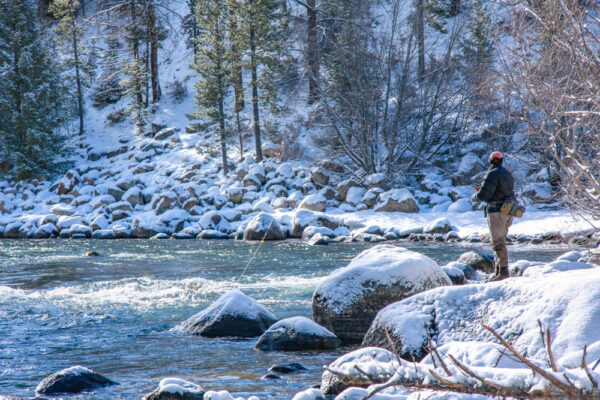After enjoying a wonderful fall with mild weather, it looks like winter has finally arrived. A winter storm hit during this week, bringing snow and cold, and the forecast looking forward looks like temps in the 30s for the foreseeable future. With the winter weather moving in, we are quickly moving into our wintertime fishing habits.
Where are the Winter Trout
 Trout move out of their summer holding areas when cold weather settles in. Fish engage in a sustentation diet during cold months and experience minimal growth. To conserve energy, trout move into slower-moving water. They generally prefer deeper water holding areas or pools (greater than 2 to 3 feet) in larger rivers for added security. The movement towards wintertime holding water produces concentrations of trout in a spattering of slow and deep runs. The majority of the rivers become nearly bereft of trout. To be successful while fly-fishing in Colorado during the winter, anglers must focus on these slower and deeper runs that hold fish. When you locate a good run, they can be productive for several hours (on larger rivers) due to the high trout assemblage. Usually, the bottom of the river in especially good water will be chock-full of trout that are winter-holding areas.
Trout move out of their summer holding areas when cold weather settles in. Fish engage in a sustentation diet during cold months and experience minimal growth. To conserve energy, trout move into slower-moving water. They generally prefer deeper water holding areas or pools (greater than 2 to 3 feet) in larger rivers for added security. The movement towards wintertime holding water produces concentrations of trout in a spattering of slow and deep runs. The majority of the rivers become nearly bereft of trout. To be successful while fly-fishing in Colorado during the winter, anglers must focus on these slower and deeper runs that hold fish. When you locate a good run, they can be productive for several hours (on larger rivers) due to the high trout assemblage. Usually, the bottom of the river in especially good water will be chock-full of trout that are winter-holding areas.
Time of day
Trout are cold-blooded and feed when water temps reach their peak during the winter months. Don’t bother fishing before 10 am, since trout will be in a deep state of semi-unconsciousness. The best hours to fish in the colder months are from 12 pm until 4 pm.
Winter nymph strategies
With some exceptions, winter fly-fishing is generally a nymph fishing game. Different patterns work well on different rivers. In general, egg patterns, stone fly patterns, and midge larvae are a good bet. On tail waters, scuds and shrimp patterns trailed by a midge larva is a good bet. The most important aspect of wintertime nymphing is to get slow drag free drifts right on the bottom of the river. Trout are not going to move far to take your flies, so long leaders with adequate weights must be used to ensure the flies get down to the fish. Takes are very subtle since the trout are not moving far during a take, and they are in a slow current. Both factors result in very little motion of the indicator. I use yarn indicators in the water since they help detect these delicate takes. Often a yarn indicator will simply flutter back or twist slowly.
Choose your river wisely
Success on winter fly-fishing trips is largely dependent on water temperatures. Many freestone rivers become unfishable when large ice shelves develop. Some freestone rivers stay ice-free, such as stretches of Arkansas River, below Pueblo Reservoir. Water that bubbles from the ground or flows from the bottom of a dam is warmer than other rivers. The warmer water temperatures result in higher levels of fish activity, making locations such as the Platte, Blue, and Colorado. The South Platte (South Platte River, Decker’s) corridor is a chain of world-class tail waters, providing a wide array of opportunities for fly fishers of all abilities. Eleven-mile Canyon and Chessman Canyon are excellent winter fisheries to explore.
Wintertime dry fly-fishing
Midge hatches occur in the early winter and again in the early spring. On rivers like the Platte, Blue, and Colorado these hatches can be very robust. Great dry fly-fishing can be experienced in these fisheries under these conditions. I prefer sunny days for good midge hatches. The hatches usually occur in the late morning.
For for information about winter flying fishing in Colorado consult with our expert.
